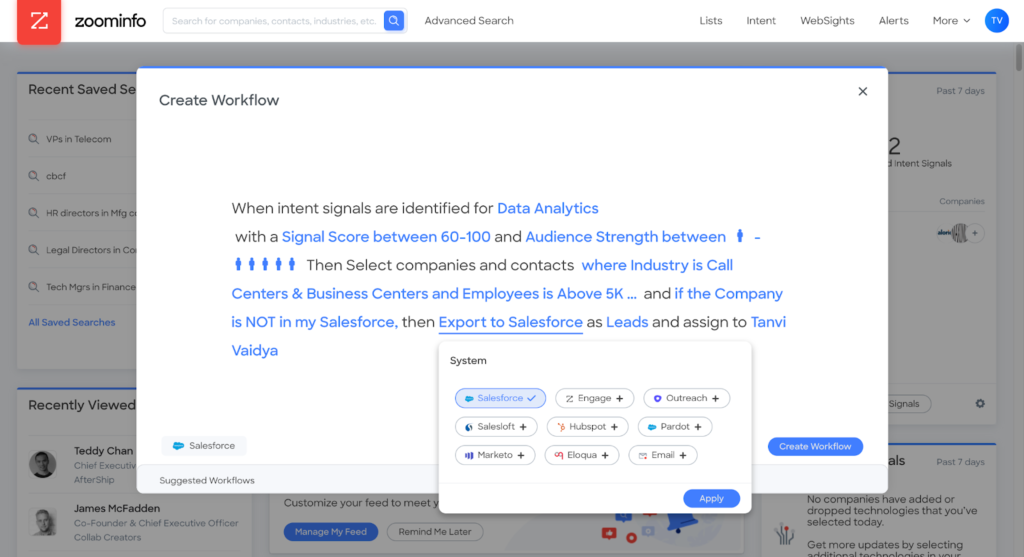ZoomInfo’s recent webinar, Automation: The Secret to Next-Level Go-To-Market Strategy, highlighted why automation powered by data is a proven tactic to accelerate win rates and better enable go-to-market plays.
The Timeless Case for Automation
A recent poll conducted by ZoomInfo found that over 85% of respondents actively look for ways to automate their work.
“Nothing in your organization is running as well as it could, especially in the go-to-market motion, so it’s important to constantly look for ways to tweak and optimize,” said Henry Schuck, founder and CEO of ZoomInfo.
Through trial and error, companies adopt “sales plays” that become repeatable and highly targeted. Businesses that dissect the workings of a great sales play can detect and initiate triggers that drive revenue.
ZoomInfo’s Workflows tool ensures that reps can easily automate their plays and ensure that potential sales opportunities don’t fall through the cracks. With this functionality, reps can select their triggers, apply filters, and perform an action — instantaneously, at scale, and on repeat.
The images below offer a glimpse into the Workflows creation process.


ZoomInfo’s Top Five Sales Plays
To help illustrate the path to success with automation, we’ll walk you through the top five sales plays favored by reps at ZoomInfo that can be used by sales teams in any industry. By swapping out job titles, for example, you’ll notice that the “triggering” moments presented below will apply to any organization’s desired course of action.
#1: The funding play
Triggering event: A small company secures a round of funding (check). Typically, a company reinvests funds back into the business for growth and scalability. This is a sweet spot for ZoomInfo.
Filtering criteria: Using the Scoops and Funding features in the ZoomInfo platform, a rep filters down to the ideal persona by industry, location, and the number of sales reps at each particular organization. Whilecriteria may vary depending on the play, for the most part, reps at ZoomInfo will continue to select the same filters — but they can easily adjust the filters that best help them tailor their research.
Action: After compiling all necessary criteria, reps gather the VPs of sales and marketing (plus any other key titles) and place them into a sales flow or sequence, thus tailoring the ensuing conversation to the prospect’s growth plan.
#2: New sales or marketing leader play
Triggering event: Using Scoops, a sales rep at ZoomInfo discovers that a company has a new sales or marketing leader. Studies show that new executives spend more than two-thirds of their available budget within their first three to six months. Because these executives are tasked with making immediate changes, there’s no better time to connect with them — or those they work directly with — about their outlook and budget.
Filtering criteria stays the same.
Action: The sales rep is now well-prepared to have a hyper-targeted conversation about the various challenges ZoomInfo can help solve for the new leader.
#3: Competitive displacement play
Triggering event: A sales rep is alerted when a certain company “spikes” in consuming content related to ZoomInfo’s competitors. This event can occur when a company surges on such ZoomInfo-related topics as “sales leads” or “sales acceleration.” Businesses that are suddenly researching pertinent content can signal key internal buying intentions that are quietly in the making. Reps who get in front of these folks can see their win rates increase by around 75%.
Filtering criteria stays the same.
Action: Once reps bucket the data they have accordingly, they can identify prospects like sales leaders and sales ops professionals with a campaign to initiate that first conversation.
#4: Customer technology play
Triggering event: This event occurs when a ZoomInfo customer adds or drops a technology (such as a tool for sales engagement) that pairs with ZoomInfo’s core offering. In this case, it’s easier for a rep to identify opportunities for alternative offerings.
Filtering criteria stays the same.
Action: Sales can add director-level individuals to email and call sequences to discuss the value of an all-encompassing, consolidated tech stack — without the integration headache. This play significantly eases the cross-sell and upsell motion to the ZoomInfo customer base.
#5: Form completion play
Triggering event: This event occurs when someone fills out a form on your website to download a gated piece of content or access a free trial of your solution. When a prospect enters the usually scarce bits of information, ZoomInfo can automatically append all other relevant data not provided by that individual, thereby dramatically increasing the “speed to lead” with additional data points that the form didn’t request.
Filtering criteria stays the same.
Action: With nearly instantaneous access to more accurate information on the prospect, sales reps can quickly kickstart their outbound motions. These strategies can include immediate outreach to the prospect or related contacts, as well as additional outreach to three to five sales leaders in the case of a delay — which further increases conversion rates and ensures reps are in front of the right people at the right time.
Ready, Set, Automate
In all of the plays mentioned above, automation plays a big part in their ability to succeed and save reps time. Using WorkFlows, ZoomInfo reps can select their triggers, sequence with precision, and turn prospects’ intent into action.
For a demo of the tool and details on how your team can begin to automate their sales plays, watch our webinar.


